Over the past few months, we have looked at both rackmount, high-end, and lower-end desktop NAS units from QNAP. The QNAP TS-873A is an upper midrange desktop NAS with a fairly unique feature: it has an AMD Ryzen V1500B CPU onboard. ln our review, we are going to go a step further, and also turn this into a ZFS-based NAS. Let us get to it.
QNAP TS-873A Hardware Overview
We are going to split the article into internal and external hardware overviews. This is simply due to the detail and is the same as we do with servers. Unlike some of the smaller NAS units, this unit has a lot going on warranting a more thorough look. We are going to mix our external overview a bit and show some of the parts that span both the internal and external domains. It still made sense to split.
QNAP TS-873A External Overview
The unit itself is 7.41 × 12.96 × 11.06 inches and is designed to be a fairly standard desktop chassis in this class. While there are some NASes on the market designed to be compact 2-4 bay models and others that are designed to be rack-mounted, this is firmly a unit designed to be used in a SMB/ home office setting. There are simple features such as a LCD status display and a front USB port to make data importing easier that we often do not see on rackmount units.
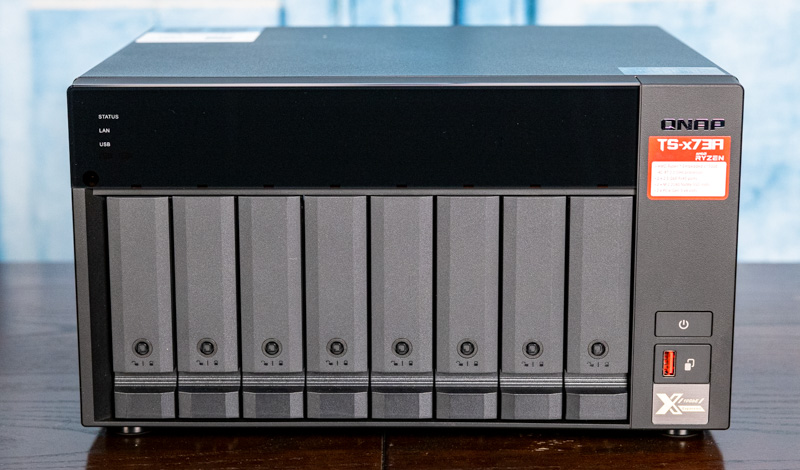
One of the nice features here is that the unit has tool-less vibration mitigating drive trays as we saw with the QNAP TVS-h1288X 12-bay NAS Review. When we reviewed the QNAP GM-1002 3U Dual ZFS NAS, we noted how drives with screws take longer to service. Here, we have drive trays that use simple snap-in pegs to secure drives. There is a recommended option for adding screws for shipping security as well. One can see the blue vibration dampeners that help further isolate vibrations to and from the drives.
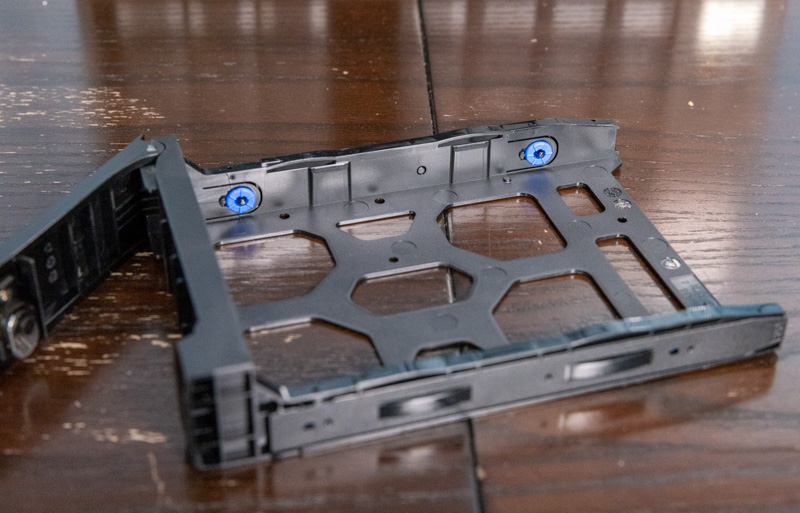
The drive trays are all locking units and one can see we also have rubberized feet below. One feature that we wanted to point out on the front of the unit is the bottom right side of the chassis. There we have a power button as well as a USB port. This is a USB 3.2 Gen2 Type-A 10Gbps port. This has the One-Touch copy button next to allowing for quickly putting data onto the NAS.
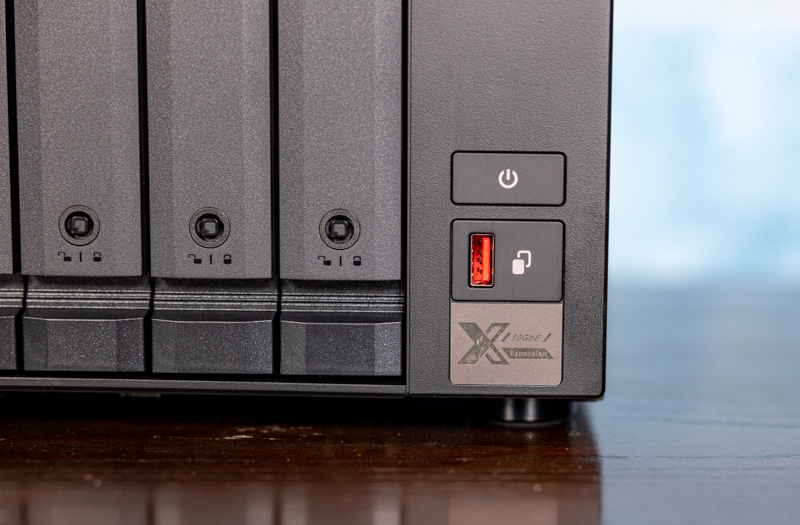
Something that we were not overly fond of is the 10GbE Expansion sticker. This is not, as it comes from the factory, a 10GbE equipped NAS. Instead, one needs to add an additional add-in card for 5GbE or 10GbE operation. Still, this is a step above some other NAS units in its class as we will cover shortly.
Moving to the rear of the unit, we see ports and ventilation holes.
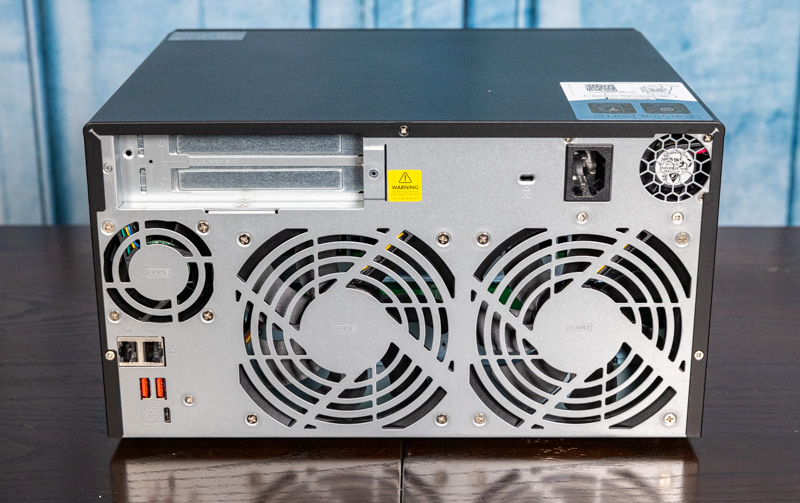
First, there are two large fans and one smaller fan that pull air through the chassis and exhaust out of the rear. The small fan in the top right corner is the 250W Delta power supply fan. We will note this unit does not have a power supply on/off switch as we have seen in some other QNAP units.
The rear I/O is straightforward. There are two USB 3.2 Gen2 Type-A and one Type-C ports. Something that is interesting here is that the three USB 3.2 Type-A ports are all 10Gbps Gen2 while the USB Type-C port is a Gen1 port and thus 5Gbps.
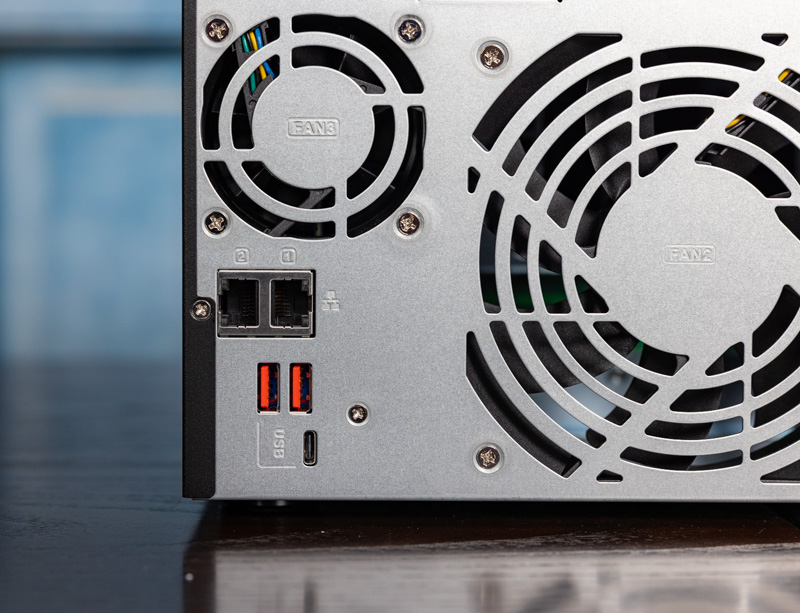
Perhaps the biggest rear feature is around the networking. There are two RJ45 ports that provide networking. Instead of these being 1GbE ports as companies like Synology generally use, QNAP has two 2.5GbE ports that can run at the lower 1GbE speeds as well. We are seeing more 2.5GbE gear so it is nice that QNAP is using a more modern standard. Not everyone will use this, but it only adds a few dollars to a BOM cost and offers 2.5x the performance of the older standards.
We mentioned above that the solution has a 10GbE expansion sticker. This sticker owes to the fact that this NAS has fairly easy-to-access PCIe slots.
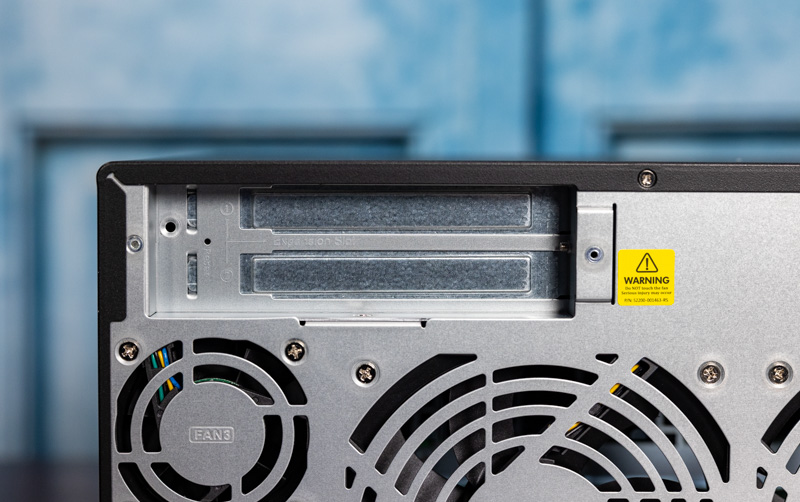
The PCIe slots are opened-ended x8 slots that are also full-height slots. One does not get a full x8 electrical though since they are PCIe Gen3 x4 slots. Still, that is plenty for dual-port 10GbE cards for example. Synology has a single expansion slot in this class of NAS. For most of our readers getting 5Gbps over two ports is going to be more useful than 4Gbps over 4 ports as is having two expansion slots. One can do 2x 10Gbase-T and 2x SFP+ ports using two dual-port cards here adding to practicality. It would have been nice to have onboard 10GbE, but at least we get 2.5GbE and expansion.
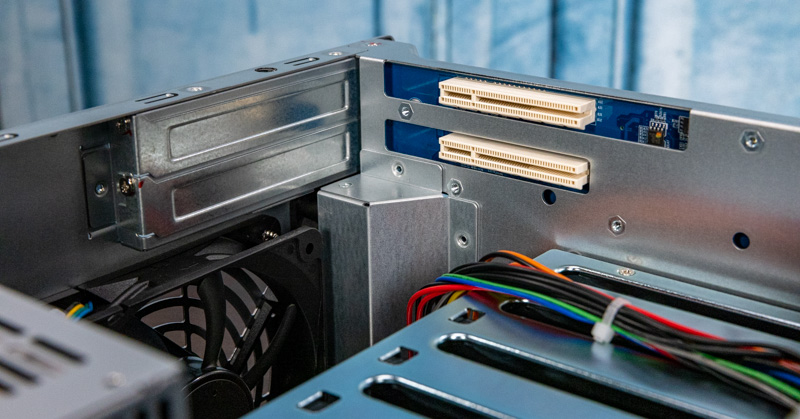
We wanted to show off more inside the system, so we are going to get to that in our Internal Overview.
Next, we are going to take a look at the internals of the system.

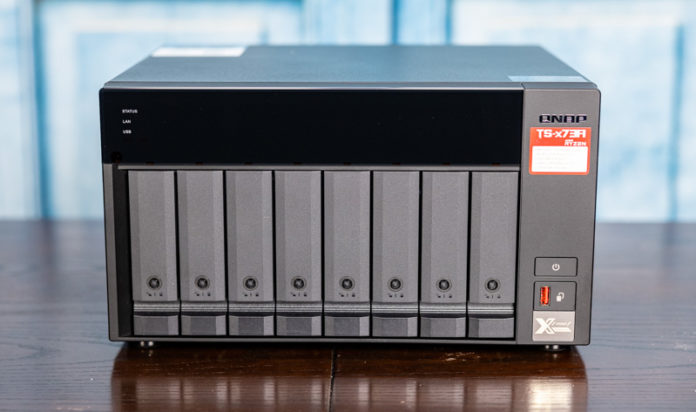


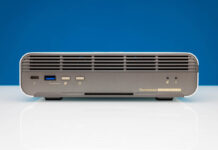
I love TrueNAS, and the TrueNAS Mini’s have 10g on some of them. You can add a 10g card and still be close to the 4 bay mini x+ and xl+ pricing and have ZFS with QNAP.
I really wish QNAP did ceph or gluster so you could scale these out
QNAP always seemed to me a rather grasping and feature splitting company. Overpriced for what you get. This thing is in essence a PC in a special case… the SOC has dual 10GbE, so QNAP equips it with a pair of third party 2.5 GbE. Really gotta shake my head at that. I presume QNAP thinks it can make more money selling you a PCIe 10GbE AIC.
Honestly if one is competent enough to configure one of these things then one is probably competent enough to repurpose an old PC into a Linux or Windows server and save a substantial amount of money.
So few companies use the AMD 10g in the Zen chips that there’s gotta be something wrong beyond the lack of SR-IOV that STH has talked about before.
This is probably the box I would get for my home office (can i get a yay for work-from-home getting extended?)
I do not find the windows inside of windows inside of Windows user interface modern. I could l overlook that annoyance, but periodically the QNAP software here forgets what routes go to which Ethernet connections and I have to open the interface on the net that works, delete and then recreate the nonfunctional routes.
Since the present review is for what is essentially a PC in a nice box without a video card, it would be good to know how easy (or possible) it is to install Linux to create an open-source NAS that leads to auditable security and fixable bugs.
What pratt thought it a good idea to put the power button next to an area where you push things in and out?
Major design fail
Hoohoo: would you be saving money though? The idle electricity use of this box is only 25 watts, that’s pretty good. Repurposing an old PC means you need a place to put the giant box, and you’re going to use much more electricity. The thing I love about this box is that it fits nicely in my TV cabinet where my cable is coming into the house, where my cable modem, router, and everything else are located, so it sits discretely in my living room, don’t think I could accomplish that by repurposing my old gaming PC.